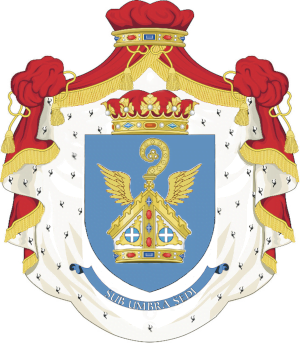The meticulous historical-theological study carried out by the Prince-Abate in charge, His Most Reverend Highness Giovanni Luca (born Gianluca de Lucia) has shown that Giorgio Carbone’s ideas aimed at reconstituting a principality in Seborga, and still supported by his successors, currently being headed today by Mrs. Nina Dobler, are largely historical forgeries. Here are the most eclectic historical forgeries.
1). Seborga became an Imperial Monastic Principality as far back as 1079
False. Seborga became an Abbatial Principality, i.e. governed by an Abbot-Prince in the year 1261, the year in which the Statutes and Regulations of the Principality were officially drawn up.
2). The Knights Templar, some Grand Masters of whom passed through Seborga, laid down their swords there and became Monks.
False.The presence in Seborga of a Chapel dedicated to St. Bernard and an Oratory erected in honour of St. John de Matha does not, in our opinion, officially confirm that the Knights of the Temple lived and then laid down their arms in Seborga. Nor does it confirm that these Knights later became the monks that constituted the Principality of Seborga, ruled by monks before its constitution in 1261, i.e. from 954 AD. Regarding the historical events of St. Bernard of Clairvaux as Grand Master of the Order of the Templars after Payen are false and not supported by historical sources. Moreover, being a religious man, how could he wear weapons like warriors? That would be heresy. Among other things, it could be that the Chapel was dedicated to St Bernard of Menthon, who had nothing to do with St Bernard of Clairvaux.
3). The deed of sale of 30 January 1729 was never registered.
False.The deed of sale authorised by Pope Benedict XIII in 1728, drawn up and registered in Paris on 30 January 1729 is preserved in the Turin State Archives.
 4). The deed of sale of 30 January 1729 concerned the simple possession of the territories of Seborga and not sovereignty over it.
4). The deed of sale of 30 January 1729 concerned the simple possession of the territories of Seborga and not sovereignty over it.
False. This deed of sale established the cession of Seborga’s territories and appurtenances such as the Chapel of San Michele (today the Church of San Michele in Ventimiglia) and the noble titles held by the Abbots of Seborga and Lerino.
5). Noting that the monks left Seborga three centuries ago, according to Giorgio Carbone, Marcello Menegatto, and Nina Dobler, the right to elect the Prince-Abate would belong to the citizens and residents of Seborga; according to Dr. Diego Beltrutti, the right to elect the prince would belong to the Knights Templar or Holy Sepulchre inspired knights, in any case founded by Giorgio Carbone.
False.From a legal point of view, it is not possible to transfer a right established by monks to third parties. In this context, the monks left Seborga as a result of the attempted sale in Paris, by virtue of the fact that the King of Sardinia made payment by means of two credit titles, received as per the receipt in deed by the Presbyter Bursar, Father Benoit de Benoit, delegated by the last Prince-Abate, Monsieur Fauste de Ballon.
6). The flag and blazon used by Ms Dobler does not represent the ancient principality.
False. Flag and blazon are the fruit of Carbone’s imagination. Looking at the flag on the left, one finds the blazon of the Greek monarchy, or even the blazon of the Italian monarchy repainted blue instead of red, and on the right are the nine blue bands representing the nine founding knights of the Order of the Temple, which we reiterate there is no evidence that the Templars had any connection with the monks of Seborga and Lerino.

7). Is the title His Serene Highness (HRH) religious?
False.The title that Giorgio Carbone assumed at the time of his self-proclamation and that Nina Dobler still uses today is a dynastic title, used exclusively by monarchs or aristocrats, not by clerics.
It is evident that the principality of Seborga, founded by Giorgio Carbone and maintained by his alleged successors, is not a true reconstruction of the ancient Abbey Principality of Seborga.


